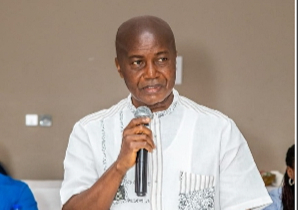- Home - News
- TWI News | TV
- Polls
- Year In Review
- News Archive
- Crime & Punishment
- Politics
- Regional
- Editorial
- Health
- Ghanaians Abroad
- Tabloid
- Africa
- Religion
- Election 2020
- Coronavirus
- News Videos | TV
- Photo Archives
- News Headlines
- Press Release
General News of Friday, 2 August 2002
Source:
Ashanti Regional Minister accounts for one year in office
The Ashanti Regional Co-ordinating Council (RCC) has prepared a 12-page paper titled "Operationalising the NPP manifesto - a Blueprint for the socio-economic development of Ashanti".
The document outlined a series of programmes, projects and activities to be implemented by the RCC in four years to create employment and wealth in fulfilment of the basic tenets of the NPP manifesto.
A release issued by the Public Relations Unit of the RCC in Kumasi to commemorate one year in office of the Regional Minister, Samuel Kwaku Boafo, (MP), said the main focus of the paper was on agriculture, health, roads, industries and tourism.
The release noted that development activities initiated and or completed within the Regional Minister's first year in office were rather lower than expected.
This state of affairs stemmed from the late or irregular release of the district assemblies common fund to the 18 metropolitan and district assemblies in the region.
It said at the regional level also, the non-release of the Public Investment programme (PIP) affected the implementation of development programmes and projects especially in education, agriculture, health and other sectors of the region's economy.
Despite the late release of the common fund and PIP, however, some development activities were either initiated or completed within the first year, the paper noted and said a total of 8.9 billion cedis was spent on road rehabilitation in the Kumasi metropolis.
Under the same road programme during the period, a total of 16.9 billion cedis was spent on the resealing, rehabilitation, pothole patching, spot improvement, routine maintenance and regular works on a number of trunk roads in the region.
The RCC had started a programme to open up the Afram Plains with the construction of a 32-kilometre road from Birem to Anyinofi at 3.3 billion cedis, adding that so far about 16 kilometres of the road had been reshaped with nine out of the 42 culverts constructed.
49.4 kilometres of feeder roads had been constructed at 1.4 billion cedis, using the labour intensive technique, while the rehabilitation, reshaping, surfacing and regravelling of a total of 413.34 kilometres of feeder roads costing about 22.9 billion cedis were on-going.
In the health sector, 11.4 billion cedis was spent on the completion of a number of rural health centres and that out of the amount, 6.036 billion cedis was being spent on upgrading the New Edubiase health centre into a district hospital.
This involved the construction of additional 30-bed ward, an x-ray department, administration block, residential accommodation for both senior and junior staff, a mortuary, a theatre and an ENT department.
Eight selected second-cycle schools were rehabilitated at the cost of 613 million cedis. They include Saint Monica's secondary school, Aduman Secondary School, Kofi Adjei Secondary/Technical School and Adu Gyamfi Secondary School.
The rest are Dompoase secondary, Prempeh College, Tweneboa Koduah and Tepa secondary schools.
On Agriculture, the most outstanding programme initiated by the Regional Minister was the cultivation and further processing of sunflower.
Last year, the Regional Minister led a delegation to Italy during which they met both Ghanaian and Italian investors including Professor Gian Paolo Vannozi of the University of Udine and that the meeting culminated in the signing of a 3.5 million-dollar loan agreement to be spent on the cultivation and processing of sunflower in Ashanti.










